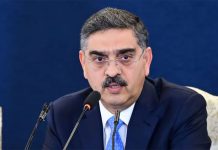
ISLAMABAD, Feb 25 (APP):Special Assistant to the Prime Minister (SAPM) on Climate Change Malik Amin Aslam has said that Pakistan intended to adapt to Zero-Carbon emission goal by 2050 in energy by using all types of renewable and low-carbon sources as the country planed to use 40,000 MW nuclear energy by 2050.
The SAPM was speaking at an International Webinar on “Nuclear energy: a key to Net Zero (Green Future)” organised by Strategic Stability Institute (SASSI) University, said a media release issued here on Friday.
Malik said, ” we will make optimal use of our wind, hydel, solar and nuclear resources to meet the goals set by Conference of the Parties (COP26) recently held in Glasgow.”
Dr Zafar Nawaz Jaspal from School of Politics and International Relations, Quaid-i-Azam University, was the moderator.
Zia ul Hasan Siddiqui, ex-Member (Power), Pakistan Atomic Energy Commission (PAEC) hoped a global policy regarding increasing the capacity of existing and new reactors. He advised to use only nuclear technology instead of fossil fuel plants for base load power generation.
He said that renewable sources were inexhaustible and free but had time, season and geographic limitations.
Emilia Janisz, External Manager of the European Nuclear Society said that nuclear energy is available, scalable and deployable. She observed that net zero demands 40% increase in nuclear energy output by 2030 and its double by 2050.
Dr Jonathan Cobb from World Nuclear Association (WNA) said that nuclear technology had a clear future.
He said that new reactors were more efficient and had more capacity than earlier lot, adding COP-26 provided space for global action.
He opined that target of 1.5 degree centigrade was weak but we had to keep it.
He said that growth was required in nuclear energy to supply 25% of electricity by 2050 under demand of 2-degree scenario.
Dr. Syed Javaid Khurshid, former President, Pakistan Nuclear Society, said that carbondioxide emissions should be stabilized at 550 ppm by 2050.
He said that vision of nuclear energy for 2030 and 2050 in Pakistan, was 8,800 MW and 40,000 MW respectively.
He proposed the global community to form international nuclear power fund to support the installation of new power plants. He asked developing countries to achieve zero targets quickly.
Mr. Tim Yeo,Chairman of New Nuclear Watch Institute (NNWI) stressed reducing greenhouse gases in this decade. Covid 19 already affected our efforts, he said adding that nuclear energy being a low-carbon base load power was needed more than ever before.
He said that threat of climate change was the biggest challenge being a threat to humanity.
He said that use of coal must stop adding that gas was also not a solution.
He said that Ukraine events highlighted the importance of energy security.
Hamid Akbar, Director Nuclear Security Programme, SASSI University, summarised the webinar. He said that it was easy to take our planet for granted until we see the human cost of its degradation.
He further added that we were humans and want the same thing every other human wants — a safe place to live on this earth. He said that Pakistan shares of nuclear energy is 7% of the total installed energy.
Answering a question, Ms Jessica said that within Europe, we produced volumes of waste but wherever possible, we used it in industry. For residual waste, she said projects were underway to provide long storage as a high level spent fuel repository would be ready by 2025 in UK while Sweden and France were also going ahead.
Chairperson and Director-General, SASSI University, Dr. Maria Sultan thanking the participants said that we sought to collaborate with the world as nuclear industry was the energy of future.